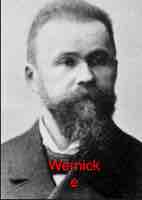Carl Wernicke
1848-1905

Carl Wernicke was a German psychiatrist and neurologist. He is best known to speech-language pathologists for his study of aphasia and for his discovery of the area in the cerebrum responsible for receptive language/speech phenomena in the superior gyrus of the temporal lobe (Wernicke aphasia).
Wernicke was born in a small town in Upper Silesia on 15 May, 1848. He received his secondary education at the gymnasium in Oppeln, near Breslau. With great difficulty his mother managed to enable her son to study medicine at Breslau University. After graduation, Wernicke took a position as assistant in the Ophthalmology Department at Breslau University for six months. Then he served in the France-Prussian war of 1870 as an army surgeon. Upon return to Breslau, he returned to Breslau University, this time as an assistant in the Psychiatric Department. He was sent by his mentor, Henrich Neumann to Vienna for a period of six months to study neuroanatomy with Theodor Meynert. It was in Vienna in 1874, shortly after his arrival at age 26, that Wernicke published his most important, Der Aphasische Symptomencomplex (The aphasic syndrome), with the subtitle: A psychological study on an anatomical basis.
In 1875, Wernicke was appointed assistant in the Berlin Charite clinic under Westphal, where he stayed until 1878. From 1878 to 1881 he practiced medicine and, more particularly, neurology in private practice. During that period Wernicke prepared a number of publications. At the same time, he maintained a strong interest in psychophysiology and aphasiology.
In 1881 Wernicke's published an authoritative text, Lehrbuch der Gehirnkrankheiten (1881 and 1883), wherein he classified brain diseases and wrote about the neurological method of localizing lesions.
In 1885, Wernicke agreed to take over the position of Henrich Neumann in the Allerheililgen Hospital and in addition he became head of the Department of Neurology and Psychiatry of the University Hospital in 1890. In the next twenty years the Breslau clinic became a center of neuropsychological investigations, where a number of eminent scientists such as Hugo Liepmann, Kurt Goldstein, Karl Kleist, and Foerster developed basic concepts, such as the apraxias, the agnosias, and the asymbolias. At the turn of the century Wernicke faced a number of problems in his relationship with the municipal and university authorities. In 1904 the course of events finally made him accept an offer to succeed Ziehen as the head of the Klinik fur Psychiatrie und Neurologie in Halle. Wernicke was was killed in a road accident in 1905.
In "The Aphasic Syndrome", which he wrote in 1874, Wernicke described what later became known as sensory aphasia (that is, defects in, or loss of, speech and expression) as distinct from motor aphasia, first described by French surgeon Paul Pierre Broca. Wernicke used the differential clinical features of the two aphasias to formulate a general theory of the neural bases of language. He also described a form of encephalopathy induced by thiamine deficiency which bears his name.
Below is a listing of Wernicke's main contributions to the study of aphasia (see also Roth & Heilman, 2000 and the website: http://mails.fju.edu.tw/~neurolng/wernicke.htm).
- He used a reflex arc model (sensory and motor centers) to explain brain function.
- He discovered the brain center for sensory aphasia or "Wernicke's aphasia".
- He did careful descriptions of functional disturbances as well as pathological detail of the brain.
- He developed a model of the brain based on differentiating brain centers, that works something like an information processing model to ascertain the location of brain lesions from symptoms and vice versa.
Writings about Carl Wernicke
Eggert, Gertrude H. (1977). Wernicke's works on aphasia: A sourcebook and review: Early sources in aphasia and related disorders, Volume 1. The Hague: Mouton Publishers.
